For the sustainably curious men who’d like to shop better but don’t know where to start, consider this your beginner’s guide to brands who are committed to making their menswear mindfully.
When it comes to shopping, consciously adding pieces to your closet is not only the better approach, but also a great way to make more carefully considered clothing choices. Choices that you’ll keep coming back to, the kinds that never seem to go out of style, are high-quality — and ideally — have a lower impact on the environment. If that sounds about right, then look no further, we’ve put together a curation of the best sustainable clothing brands for men that tick most of the eco-friendly boxes and help you elevate your style for the long haul.
From organic loungewear to business casuals that’ll have you rethinking the assumption that anything eco-friendly is frumpy, discover 20 ethical men’s clothing brands that will make you feel good about where you’re spending your hard-earned money.
Where to Find Men’s Sustainable Clothing Brands:
Transparency note: this guide contains affiliate links, meaning we earn a small commission if you choose to shop through these links which helps us continue this site. As always we only feature brands that meet strict criteria for sustainability that we love — and that we think you’ll love too!
1. Harvest & Mill
If you ask us, sustainability starts with everyday essentials. Right from the pajamas you wear, to the tees you have on rotation, knowing that your day-to-day basics were made responsibly, locally, and can be composted at the end of their life will bring you a level of eco-ease. That’s the sort of confidence you can have in the organic cotton essentials from Harvest & Mill.
All of their pieces are crafted from natural, dye-free organic cotton, some of which are made from heirloom variety cotton that naturally grows in shades of brown, green, and red.
What you’ll find: everyday casual wear and loungewear
Price: $$-$$$
2. Patagonia
Your next outdoor adventure will feel all the more relaxing when you know your clothes and gear were made with the pristine nature around you in mind.
A company that recently made headlines after founder Yvon Chouinard gave the business away to fight the climate crisis, sporting Patagonia gear is also about standing for a better way to do business.
Expect to find high-performance gear and clothing made from the most mindful materials and recycled fibers that are making a difference. For used Patagonia apparel and gear, check out their Worn Wear site.
What you’ll find: outdoor clothing, casual wear, loungewear
Price: $$-$$$
3. Asket
Curating a lasting wardrobe is not too dissimilar to building a retirement portfolio. Just like valuable assets, your clothes should be in it for the long haul and offer a higher return on investment. But every portfolio needs an advisor, and there’s no brand that offers high-quality wardrobe perennials like Asket.
Their permanent collection is chock full of everyday essentials that’ll outlive passing trends and seamlessly transition from season to season and is crafted from materials like organic cotton, TENCEL Lyocell, reclaimed wool, and recycled cashmere.
Lyocell, reclaimed wool, and recycled cashmere.
What you’ll find: business casuals, casual wear, intimates, and other everyday essentials
Price: $$-$$$
4. Toad&Co
A mission-driven brand that started out by offering outdoor gear, Toad&Co now creates ethically made men’s clothing items that work for everyday adventures like comfortable activewear, cozy loungewear, smart casuals, and snuggle-worthy outerwear crafted in the best eco-friendly materials.
The brand also partners with a warehouse that employs and trains individuals for disabilities, while facilitating outdoor adventures for them, for some of whom, these trips have been the first adventures they’ve ever had.
What you’ll find: casuals, activewear, outdoor clothing, and loungewear
Price: $$-$$$
5. Grailed
A secondhand online marketplace with no shortage of menswear, Grailed is a great place to explore the coolest streetwear finds, along with designer pieces from the likes of Balenciaga, Dior, Gucci, and many more in near-mint condition if you’re in the market for a budgeted luxury buy.
All of their big-ticket designer items have been authenticated using a combination of human and machine moderation to help ensure everything you buy is legit.
What you’ll find: casual wear, loungewear, and business casuals
Price: $$-$$$$
6. No Nasties
No Nasties is an Indian sustainable clothing brand that creates everyday essentials for men in organic materials using no nasty processes, just as its namesake so aptly suggests.
With “emit less, balance the rest” as its mantra, the brand offsets the carbon footprint of every product they make, while also eliminating waste, and upcycling its overstock fabrics into new styles.
What you’ll find: casual wear, loungewear
Price: $$
7. unspun
Ever dreamed of owning a pair of well-fitted denim jeans that don’t require a belt to stay in place? The denim makers at unspun are here to make those dreams come true.
Unspun creates customized jeans on a made-to-order basis using a 3D scan of your body to offer you the best fit ever. Their denim is crafted from organic cotton material and processed with low-impact dyes using water that’s recycled and fed back into the system.
The bonus: If you’re dissatisfied with the fit, they’ll alter it for you free of charge!
Intrigued to know more? We broke down the steps on how you can get a custom-made pair from them online in this guide.
Price: $$$
8. Story mfg.
For the men who enjoy sporting a great print on their clothing, appreciate art, and sartorially enjoy channeling their hippie side, Story mfg. has everything you need. With a high focus on craft and non-toxic clothing processes, the brand even states that they carry out the natural dyeing in a re-planted forest where all of their waste is used to fertilize the gardens right after.
Consider this your one-stop shop for print-happy graphic t-shirts, patchwork jackets, and hand-knitted sweatshirts.
What you’ll find: casual wear and loungewear
Price: $$-$$$
9. Outerknown
Move over coastal grandma, Outerknown has been mastering the laid-back coastal lifestyle look since 2014. Co-founded by surfing legend, Kelly Slater, the brand is known for its après surf style offerings that include cozy blanket shirts to layer up in, crew neck sweaters, relaxed fit denim, and a lot more that are made from conscious materials like organic cotton, hemp blends, along with recycled polyester and nylon for its performance wear, like the high-performance swim trunks that were developed and tested by the pro-surfer himself.
What you’ll find: casuals, activewear, loungewear
Price: $$-$$$
10. Kotn
If you’re searching for timeless pieces that don’t adhere to ever-changing trends and were made to last in a sea of throwaway clothing, then look no further. Kotn’s range of elevated everyday basics comes in minimalist neutrals that can easily work with your existing wardrobe and help you level up your style quotient.
Made from low-impact fibers like linen, lyocell, organic cotton, and other cotton varieties, the brand uses its profits to help fund the education of children in rural Egypt, where some of its cotton is grown.
What you’ll find: casual wear, loungewear
Price: $$-$$$
11. Armedangels
Armedangels is a German brand that’s creating sustainably-minded everyday basics. Think t-shirts, shirts, polos, knitwear, outerwear, and denim, everything that lays the very foundation of your wardrobe, but made better.
With a special focus on creating low-impact denim, their DetoxDenim range is free from the slew of toxic dyes and chemicals that are usually found in the production process of conventional jeans. While their Circular denim is mechanically recycled and consists of 20% recycled organic cotton residues and waste from their own production.
What you’ll find: casual wear, loungewear
Price: $$-$$$
12. De Bonne Facture
Derived from the French expression that describes “a way of doing things well”, De Bonne Facture marries Parisian style with skilled craftsmanship to bring you sophisticated separates made from the finest eco-conscious materials.
With high importance on provenance, each piece comes with a hangtag detailing the name, locality, and history of the atelier that made it, just like fine French wine.
What you’ll find: casual wear, business casuals, loungewear
Price: $$$
13. Ecoalf
Born out of the vision to stop carelessly using natural resources, Ecoalf creates most of its clothing using recycled materials, predominantly ocean plastic. Since 2015, the brand has been collecting plastic waste with help from the fishing industry and transforming it into yarn and fabrics to produce high-quality sustainable clothing for men and women.
From slick streetwear casuals to loungewear essentials and weather-resistant clothing, Ecoalf has everything you need to hit the slopes or streets in style.
What you’ll find: streetwear, activewear, outdoor clothing, and loungewear
Price: $$-$$$
14. Opera Campi
Opera Campi is an Italian made-to-order men’s slow fashion brand that uses hemp as its hero fabric. Full of enduring everyday styles that speak to the minimalist aesthetic, their hemp fabric comes in all-natural and woolen blends to suit your seasonal needs.
We love the fact that they’ve invented a “moon button” from a sustainable metal that gets its namesake from the patinated look it achieves after being buried in microorganism-rich soil for three days.
What you’ll find: casual wear, loungewear
Price: $$-$$$
15. Nudie Jeans Co.
If you’re in the market for a fresh pair of lifetime-quality jeans, then look no further. Nudie Jeans Co. creates its denim material from 100% organic cotton in a wide variety of washes and styles. The brand also repurposes and recycles its used jeans to resell them as secondhand styles.
We love the fact that each one of their fit styles has a quirky name to it instead of the run-of-the-mill straight, slim, or wide leg. Whether you’re leaning towards a Lean Dean, Rad Rufus, Thin Finn, or Gritty Jackson, there’s a fit style to suit every taste.
What you’ll find: denim jeans, along with casual wear and loungewear pieces
Price: $$-$$$
16. Olderbrother
Featuring cool casuals in a color palette defined by nature, Olderbother is a men’s sustainable fashion brand that treats its clothing using nature-derived hues from oak tree barks, gooseberries, turmeric, and other plant sources. The resulting colors feature intentional imperfections and unevenness that will become darker when exposed to the sun and over time.
Primarily crafted from organic cotton, their range of elevated casual wear also features unique blends of wool, woven rice paper, and linen.
What you’ll find: casual wear and loungewear
Price: $$$
17. JCRT
JCRT is a zero waste men’s slow fashion brand that creates all things plaid in polished styles on a made-to-order basis. But, don’t let their love of plaid intimidate you, these tartans come in cool color combinations, while some pieces are remixed with elements like skulls, journal notes, shapes, and symbols to create a unique print that’s processed using low-impact dyes and less water, compared with traditional garment production.
What you’ll find: casual wear and loungewear
Price: $$-$$$
Read More About Conscious Fashion:
About The Author:

Jharna Pariani is a fashion writer and creative strategist whose work is rooted in honesty and deep observation of the world around her. When she isn’t busy penning down her thoughts, she moonlights as a video editor creating fashion and food reels on Instagram for several brands and influencers
The post 17 Men’s Sustainable Clothing Brands You Should Have on Your Radar appeared first on Conscious Life & Style.
17 Men’s Sustainable Clothing Brands You Should Have on Your Radar
Green Living
How Toad&Co’s Clothes Help Everyone Enjoy the Outdoors
This is a sponsored article about a brand that was independently assessed by our rigorous ratings system. We’re proud to only collaborate with “Good” and “Great” rated brands. Learn more.
US brand Toad&Co has a socially and environmentally responsible approach to clothing, creating pieces inspired by the outdoors and with a lower impact on the environment. Not to mention an enduring commitment to helping everyone get outdoors through its work with non-profits. Read on to discover the brand’s environment-first ethos.
Focusing on what matters most
“We make feel-good clothes for positive impact—fostering community around doing good, enjoying life’s simple pleasures, and embracing the unexpected,” says Sarah Palladino, director of people and impact at Toad&Co as she introduces the Californian brand. This “simple pleasures” concept applies to Toad&Co’s approach to design, too, and prioritises quality and responsibility over trend-led items. This, in turn, means the brand focuses its energy on clothes that are comfy and practical enough for everything from work to outdoor exploring, and on maintaining its ongoing commitments to using lower-impact materials, partnering with cleaner factories, and looking for new ways to do more with less.
Since day one, it’s been about more than just clothes. From choosing sustainable practices in every corner of our business to supporting programs that protect the planet and make the outdoors more accessible to everyone—knowing we stand for more is what keeps us going
Gordon Seabury – CEO at Toad&Co
Lower-impact materials and producer responsibility
Opting for lower impact materials is one of the core ways brands can address their impact on the planet: “Sustainable materials make a world of difference,” Toad&Co says. “We use organic cotton, recycled fibres, and other high-quality materials known for low-impact growing and cleaner manufacturing.”
The brand’s selection of more sustainable materials includes organic cotton, hemp, TENCEL Lyocell, and recycled fabrics like wool, cotton, and polyester. It also looks to third party clothing certifications like bluesign®, OEKO-TEX® STANDARD 100, and Global Organic Textile Standard, and it publishes its list of restricted substances for all to see.
Toad&Co also operates a resale platform, called ToadAgain, online and at its IRL store in Maine, US, to keep its clothes in the loop.
Supporting non-profits and access to the outdoors
Toad&Co donates 1% of its profits to organisations working to empower others and, in particular, enable better access to the outdoors for all.
In 1996, Toad&Co partnered with Search, Inc. to co-found the Planet Access Company, a full-functioning warehouse that trained and employed up to 70 adults with disabilities annually.
Determined not to stop at the front door, the brand also co-founded Search for Adventure in 2004, a unique travel program to facilitate vacations for adults with disabilities. Over 20 years later, the social venture partnership has evolved—and includes a flagship store in Chicago, a program called Visibility Arts that nurtures creativity through sharing Search, Inc. artist’s work, neurodiversity and disability awareness training, and an expanded Search for Adventure program. In 2024, the brand supported 147 nights of camping for adults with disabilities through the program.
We give back to—and partner with—organisations that align with our three pillars of giving: conservation for human enjoyment, equity and accessibility, and do the right thing
Sarah Palladino – director of people and impact at Toad&Co
One of Toad&Co’s key partnerships is with Brave Trails, which is dedicated to LGBTQ+ youth leadership, to support it in putting on accredited camps, mentorship programs, and meet-ups for LGBTQ+ youth.
Shop favourites from Toad&Co’s new collection
Read on to discover some of the standout items that balance style with practicality from Toad&Co’s lineup.
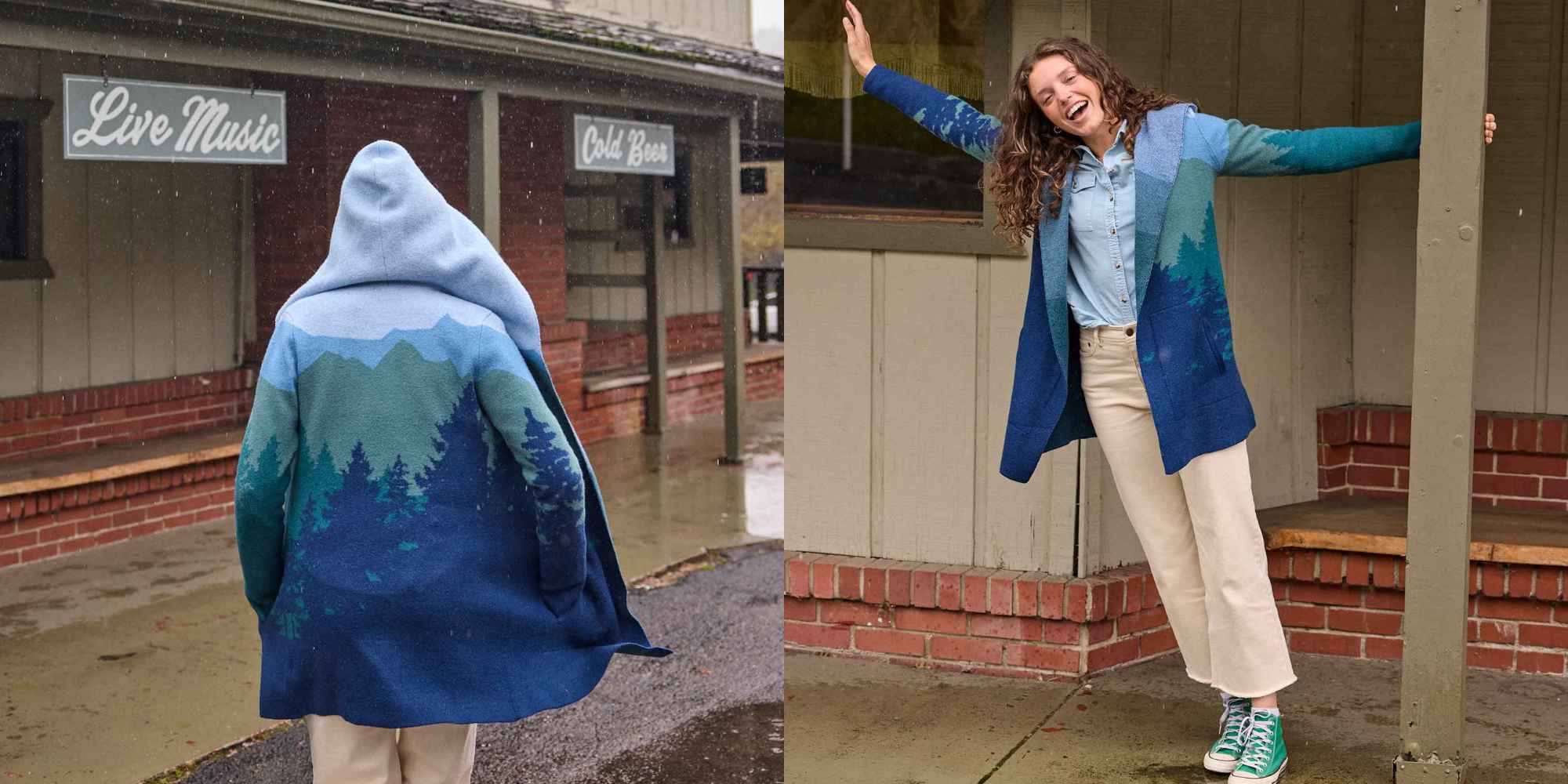
Woven with a beautiful alpine jacquard pattern, this hoodie is made from non-mulesed Merino wool and features pockets at the sides. It’s ideal as a mid-layer under a longer coat when you’re out exploring, or as a cosy item for grabbing a post-walk hot chocolate.
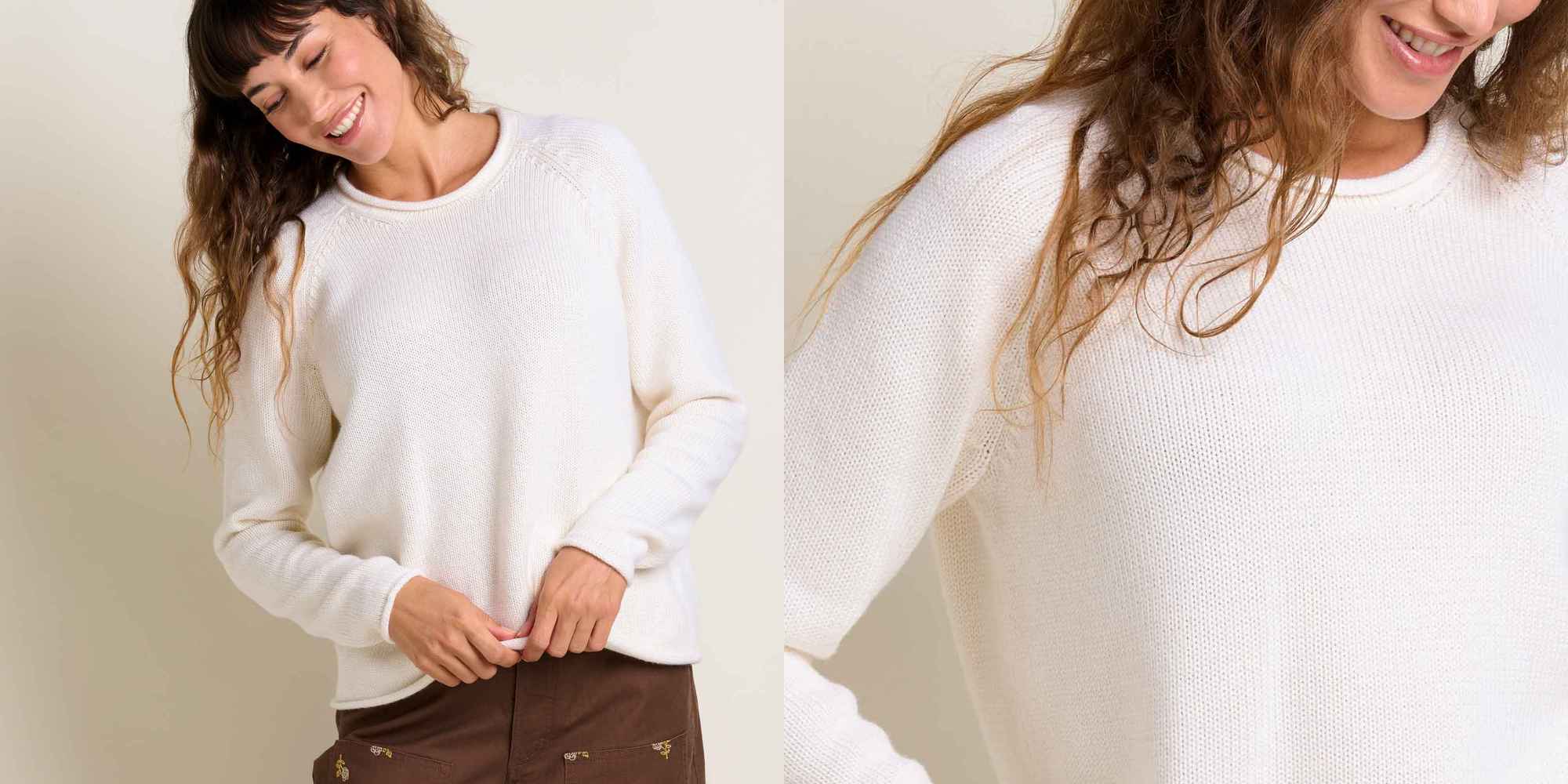
This Alpineglo sweater is a blend of 50% organic cotton and 50% non-mulesed Merino wool, so it’s going to help regulate your temperature in most climates. On top of that, the neutral tone and straight fit make it really versatile—you’ll be reaching for it on the regular.
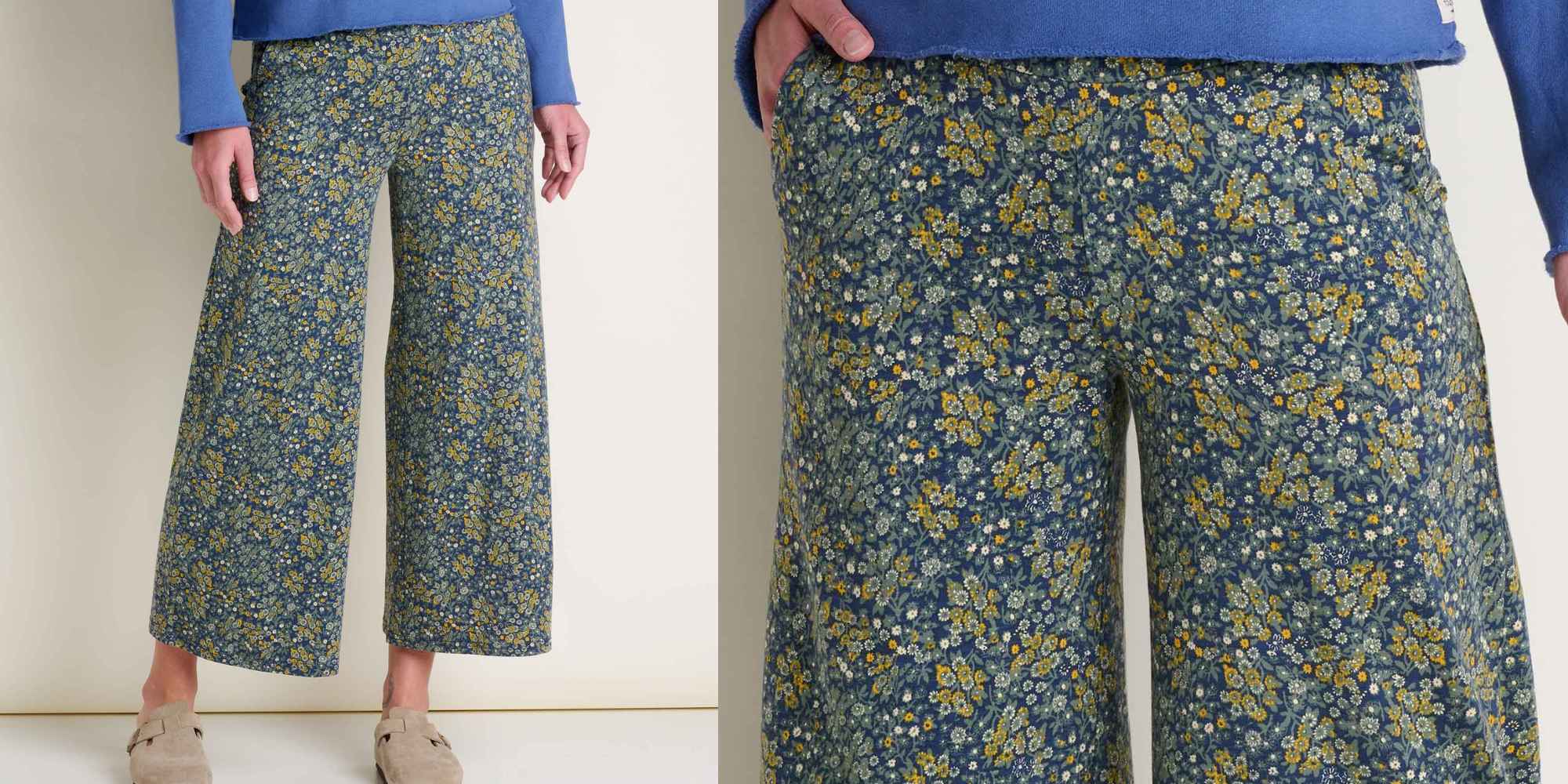
Toad&Co calls these cropped trousers “sweatpant comfortable, going-out presentable”, which makes sense, given they’re made with organic cotton and Tencel Lyocell for softness and have a comfortable wide waistband, not to mention a pretty floral pattern.
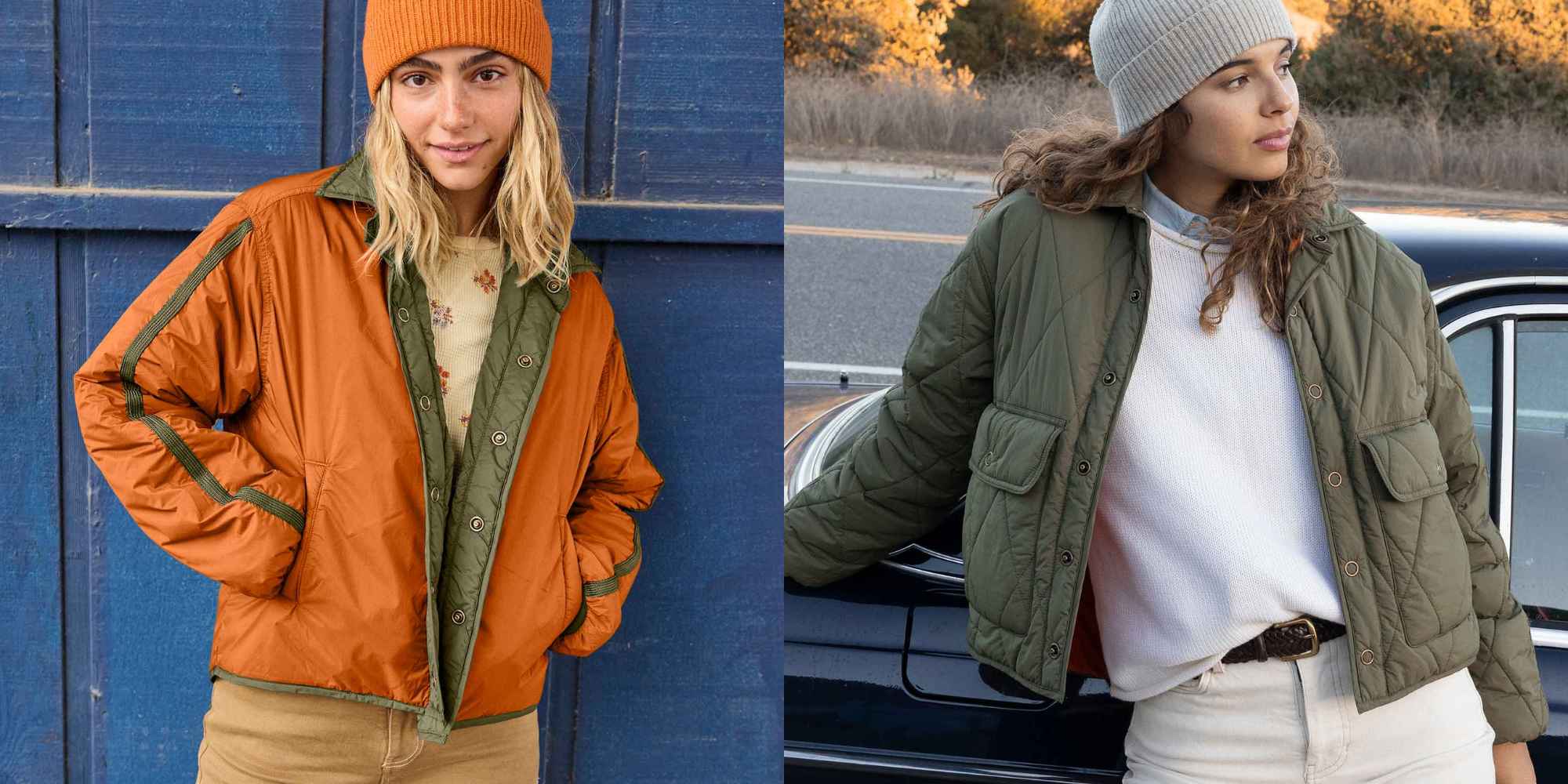
This Nomader jacket is reversible, packable, and water-resistant. In other words, it’s the ideal item to take with you for outdoor adventures. It’s made from recycled nylon and lightly quilted for warmth.
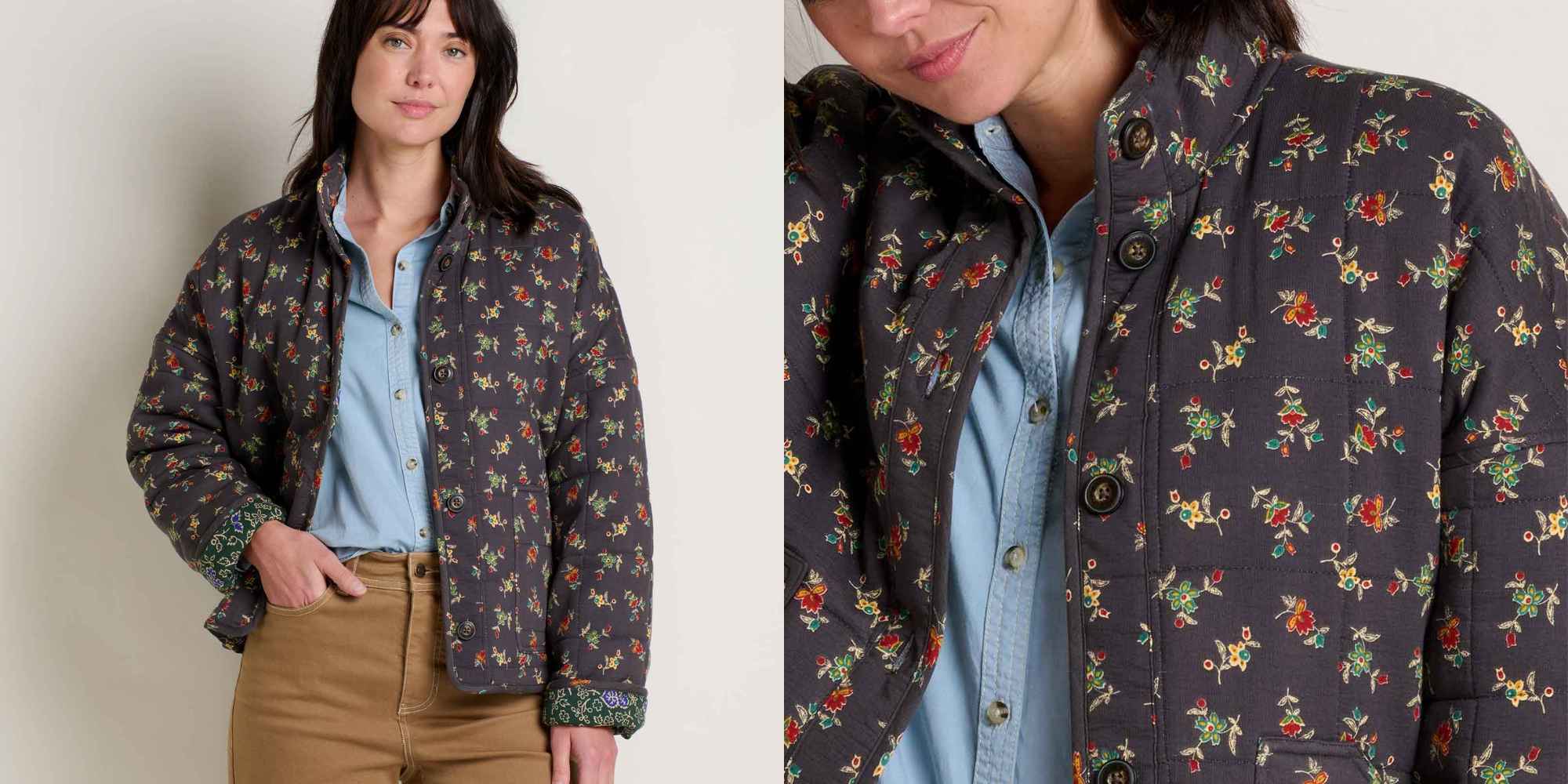
Toad&Co picked the crepe-like organic cotton for this jacket so that you could fold it away in a bag and have it still look presentable when you pull it out. It’s also packed with recycled polyester padding for extra warmth.
 Balsam Cutoff TrousersThese Balsam Trousers are made with a tiny bit of stretch and a special waistband for comfort, so they’ll flex with you and feel good all the time. The neutral brown colour also goes with so many options.
Balsam Cutoff TrousersThese Balsam Trousers are made with a tiny bit of stretch and a special waistband for comfort, so they’ll flex with you and feel good all the time. The neutral brown colour also goes with so many options.These Balsam Trousers are made with a tiny bit of stretch and a special waistband for comfort, so they’ll flex with you and feel good all the time. The neutral brown colour also goes with so many options.
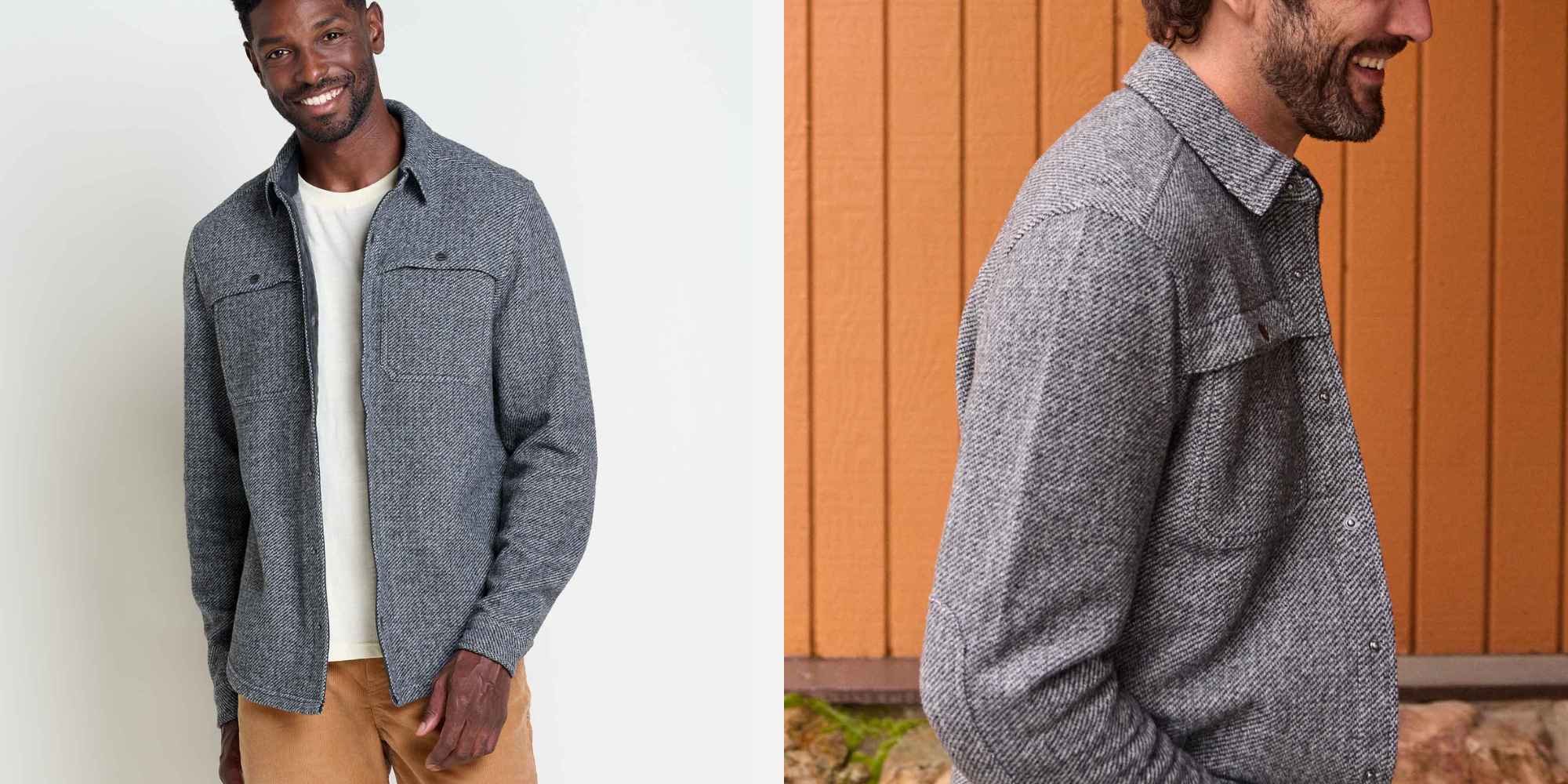
Going from a walk to dinner? From the office to drinks? This Kennicott shirt jacket fits the bill for all of the above. The smart twill fabric incorporates recycled Italian wool.

This is Toad&Co’s Re-Form Herringbone: a blend of recycled cotton and polyester that offers a soft drape and an attractive herringbone weave that looks smarter than the average checked shirt.
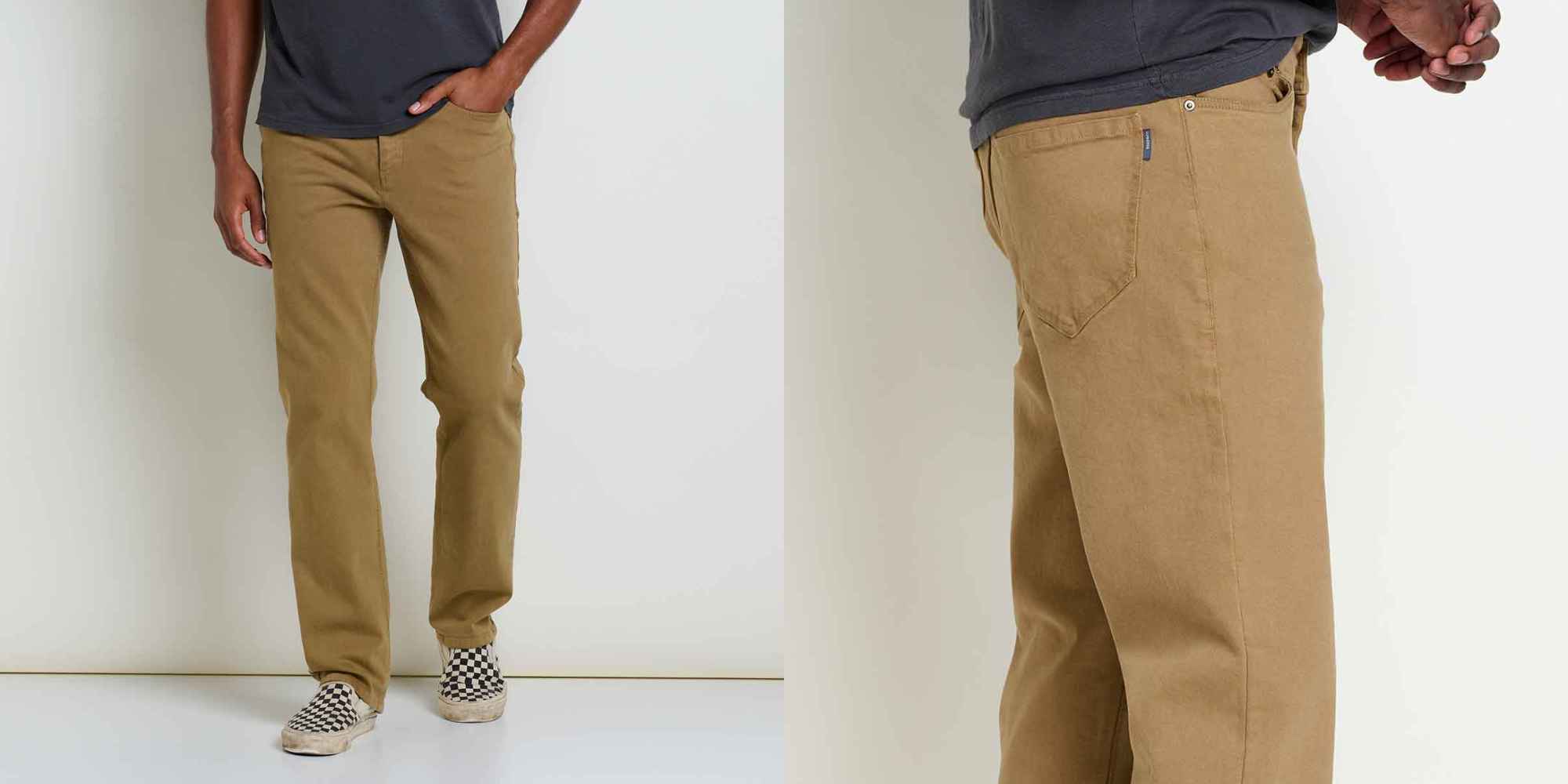
Like the women’s equivalent, these Balsam trousers have a touch of stretch and a comfortable ‘FlexForm’ waistband that mean they’re going to feel comfortable from the get-go—and you won’t need to worry about a belt, either.
Discover more of Toad&Co’s clothes.
The post How Toad&Co’s Clothes Help Everyone Enjoy the Outdoors appeared first on Good On You.
Green Living
50 DIY Christmas Presents Anyone Can Make
Last Updated on November 21, 2025
If you’re on the handmade Christmas kick this year, you’re not alone. So am I!
I’m choosing presence over presents this year and bringing back the 90s Christmas I loved as a kid – simple, crafty, low pressure, and full of small moments that feel meaningful.

If you want to gift thoughtfully, and without breaking the bank, these DIY Christmas presents are for you. There’s something for everyone on this list – whether you prefer easy or complex DIYs.
I’ve included all kinds of DIYs – beauty, cooking, fashion, and practical gifts alike. Best of all? Many of these tutorials are zero waste (or close to it).
what are good homemade Christmas gifts?
Good homemade Christmas gifts include consumable items, like homemade nut butters, vanilla extract, or jams. But not all homemade gifts are edible – you can also make items like bath bombs, candles, body scrubs, beeswax wraps, and so much more.
If you’re extra crafty, you could even make wooden gifts (like shelving or tablet holders), ceramic items (like mugs or jewelry), or knitted/crocheted pieces (like blankets, scarves or hats).
It all depends on your level of skill, time at your disposal, and ingredients/materials you have access to.
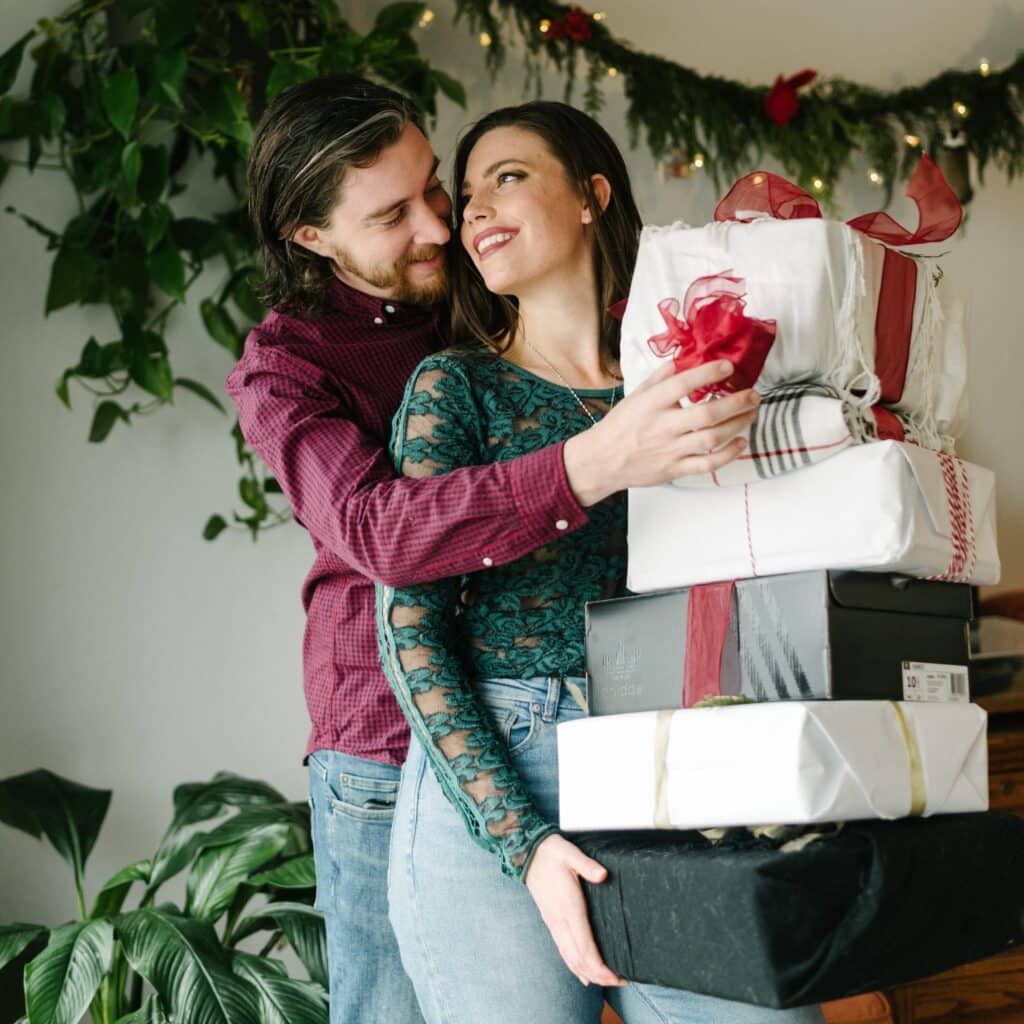
what are good inexpensive Christmas gifts?
Some good inexpensive Christmas gifts are DIY cornstarch ornaments, handmade body or lip scrub, seasoned salt blends, and homemade treats (like these chocolate chip cookies or vegan sugar cookies).
And never forget to hit up your local thrift store – you can find so many great items that would make affordable gift baskets!
Wrapping DIY Christmas gifts also doesn’t have to be expensive. Reusing gift bags and ribbons from last year, upcycling packaging paper, or even repurposing a scarf for furoshiki wrap are all low-waste and affordable!
RELATED: Gift Wrapping: How to Keep It Easy, Eco and Chic
how can I make a last minute gift?
You can make a last minute gift by getting crafty using the materials you have on hand!
For example, if you have a cardboard box, why not try making an upcycled cardboard dollhouse, vehicle, or pirate ship for a child? For adults, a DIY storage container or a shoe rack works.
One of my fav last minute gifts is scented bath salts in an upcycled glass jar – just a little Epsom salt and essential oil blends will do the trick!
Here’s my list of DIY Christmas gifts – something for everyone and every skill level.

- Bath salts
- DIY makeup like mascara/eyeliner, or lip to cheek
- Bath bombs
- Lip scrub
- Lip balm
- Face mask
- Body lotion
- Natural perfume
- Dry shampoo
- Shampoo bar
- Body soap
- Deodorant
- Rose water toner
- Hand-poured coconut/soy/beeswax candles
- Simmer pot in a jar
- Cookie, brownie, soup mix or hot cocoa mix in a jar
- Handmade seasoning blends
- Vanilla extract
- Vegan caramels or plant-based butter wrapped in compostable parchment paper
- Herb or citrus infused olive oil
- Peanut butter + jam
- Beeswax wraps
- Apple or pumpkin butter
- Sourdough or no-knead artisan bread
- Finished embroidery hoops
- Embroidered pillows, tote bags, clothes or cloth napkins
- Sewn cotton rounds
- Knitted scarf, hat, gloves, sweater, or blanket
- Hand warmers
- Quilt blanet, quilted coat or quilted wallet
- Tie dyed secondhand silk scarves, clothing or sheets
- Hand painted or drawn artwork
- Air dry clay paint palette
- DIY wooden frame for paintings or print photos
- Handmade ceramics (mugs, chawan, chasen holder, vase, spoon rest, etc.)
- Woodworked items (birdhouse, shelving, bookcase, wall guitar mount)
- Carving wooden bowls by hand
- Natural branch coasters
- Plant propagations in one of these DIY planters
- Seed balls using native seeds
- Handwoven baskets or bowls
- Macrame produce bag
- Macrame plant hanger
- Fabric paper mache bowls
- Upcycled paper earring jewelry
- Clay earrings
- Handmade plush toys
- Felt ‘food’ toys
- Wooden toys (like vehicles, blocks, or dollhouses)
- Knit or crocheted baby clothes
What do you think of these DIY Christmas presents? Let me know in the comments!
The post 50 DIY Christmas Presents Anyone Can Make appeared first on Going Zero Waste.
Green Living
8 Best Non Toxic Rugs For a Sustainable Home
Last Updated on November 6, 2025
Did you know most rugs are made from polyester, aka plastic? Arguably, a good chunk of our furniture and home decor is nowadays.
And lets not forget – rugs can get a lot of foot traffic. If it’s made from polyester, chances are those plastic fibers are going to shed and get onto us. Or worse, in us.

Some of the links in this post are affiliate links; for more information please see my disclosure policy.
Microplastics have been found in human feces, blood, and even placentas. And according to a study from Stanford University, those who had microplastics in their plaque had a higher risk of heart attack, stroke and death than those who didn’t.
On top of this, 5 billion pounds of rugs go to waste each year – that’s 2% of total US landfill. And if they’re made from plastic? They won’t biodegrade.
It’s more important than ever to reduce our exposure to microfibers where we can. Which is why I’ve rounded up the best non toxic rugs on the market.
what is the least toxic rug?
The least toxic rug will have sustainable materials and use no harsh chemicals (like PFAs) in their production.
Here’s what to look for when purchasing a non-toxic rug:
- Sustainable materials, such as organic cotton, jute, sisal or wool
- Low-waste packaging + delivery
- Natural, non-synthetic dyes
- Third-party certifications like OEKO-TEK, Fair Trade, GOTs
- Easy to spot-clean or machine wash
- Available in various styles, patterns + colors to suit your needs
do all rugs have PFAS?
According to Department of Toxic Substances Control (DTSC), only four samples of 201 carpets and rugs were found to contain more than 100 parts per million in their fibers, indicating PFAS were intentionally added to the products.
However, while PFAs may not be a huge concern for rugs, microplastic pollution is, specifically if your carpet is synthetic. Your best bet is to check the material your rug is made from and choose natural fibers whenever possible.
what is the best non-toxic rug for nursery?
The best non-toxic rug for a nursery would be made from natural materials like wool and organic cotton (which are soft on baby’s skin).
I recommend also checking for natural latex for the rug backing and underlay pads. Brands on this list that offer kid-friendly sizes and patterns include Lorena Canals, Nestig, Quince, and Loomy (more on each below).
what brand of rugs are non-toxic?
The brands of rugs that are non-toxic are listed below. I’ve gone ahead and highlighted some of my favorite features of each brand, but it isn’t an exhaustive list. Be sure to check out their websites for more information.

1. hook and loom
- Various rug sizes, shapes + patterns
- Made from GOTs certified organic cotton, recycled cotton + wool
- No dyes or harmful chemicals
- No latex
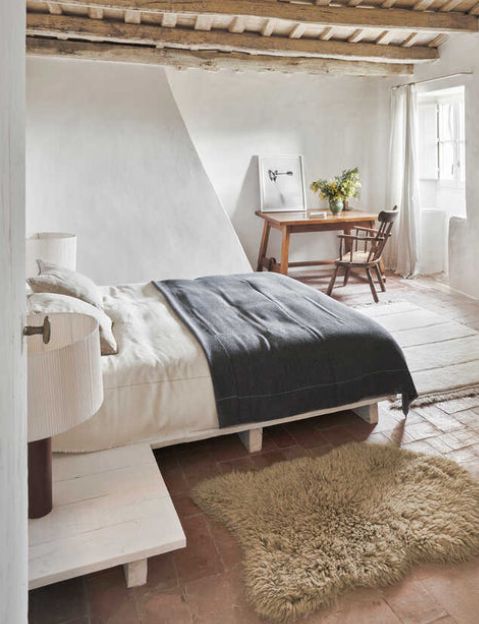
2. lorena canals
- Various rug sizes, shapes + patterns
- Handmade by artisans using recycled materials like organic cotton + wool
- Nontoxic dyes
- Make your own option
- Machine washable
- Rugcycled line made from recycled materials in their own factory
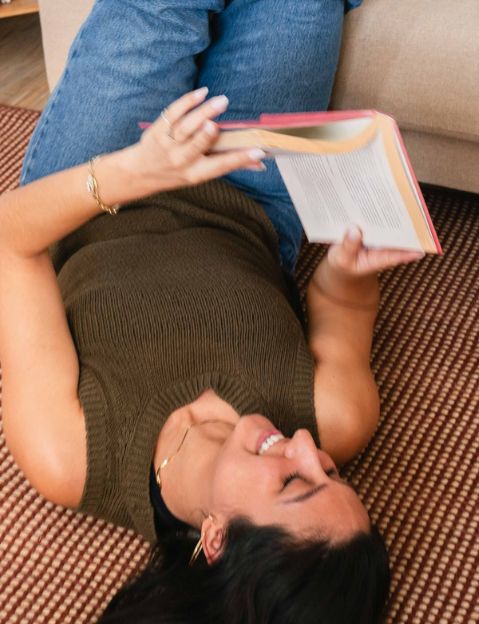
3. sabai
- Field rug
- Woven using wool + jute
- Available in 3 varying sizes
- Rug pad add-on available for reduced movement
- Certified B Corporation

4. quince
- Various sizes + patterns, best known for vintage-inspired looks
- Made from natural materials like wool, jute, + cotton
- Handcrafted by artisans in India
- Transparent pricing practices
- Compostable poly bags + recycled plastic mailers

5. west elm
- Rugs for every area of the home, in varying sizes
- Made from wool, jute, hemp, cotton, TENCEL + recycled materials
- Handspun by skilled artisans in India
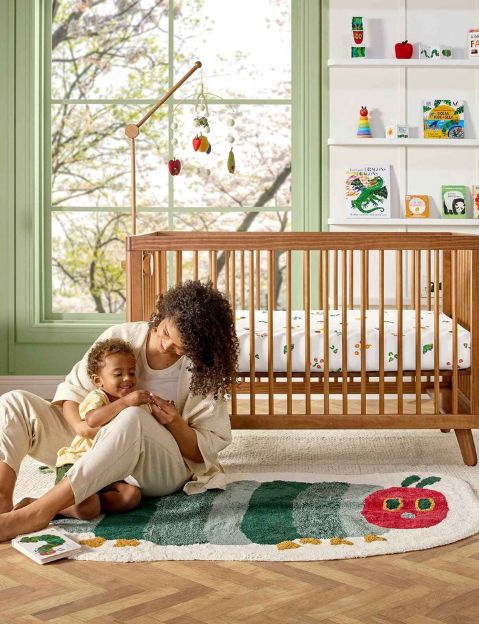
6. nestig
- Area + washable rugs made with fun shapes/designs for babies + kids
- Washable rugs made with organic cotton + nontoxic dyes
- Area rugs made with cotton + each colored element crafted from recycled cotton
- Handmade in Brazil

7. cold picnic
- Various rug shapes + sizes, abstract patterns + bold colors
- Made with wool, bamboo silk, cotton, hemp, + deadstock materials
- Designed in a Brooklyn studio, handmade by artisans in India
- Committed to reducing packaging waste where possible
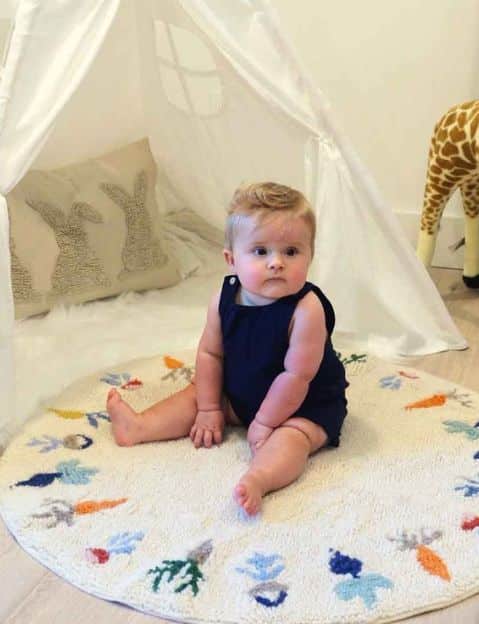
8. loomy
- Various rug sizes, shapes + patterns
- Made from banana silk, hemp, jute, recycled fiber, viscose, or wool
- Any colored yarn dyed using low-impact techniques
- Handcrafted by indigenous artisans
So what do you think of these non toxic, sustainable rugs? Let me know in the comments!
The post 8 Best Non Toxic Rugs For a Sustainable Home appeared first on Going Zero Waste.
-
Climate Change4 months ago
Guest post: Why China is still building new coal – and when it might stop
-
Greenhouse Gases4 months ago
Guest post: Why China is still building new coal – and when it might stop
-
Climate Change2 years ago
Spanish-language misinformation on renewable energy spreads online, report shows
-

 Greenhouse Gases2 years ago
Greenhouse Gases2 years ago嘉宾来稿:满足中国增长的用电需求 光伏加储能“比新建煤电更实惠”
-
Climate Change Videos2 years ago
The toxic gas flares fuelling Nigeria’s climate change – BBC News
-

 Climate Change2 years ago
Climate Change2 years ago嘉宾来稿:满足中国增长的用电需求 光伏加储能“比新建煤电更实惠”
-

 Carbon Footprint2 years ago
Carbon Footprint2 years agoUS SEC’s Climate Disclosure Rules Spur Renewed Interest in Carbon Credits
-
Renewable Energy5 months ago
US Grid Strain, Possible Allete Sale




















